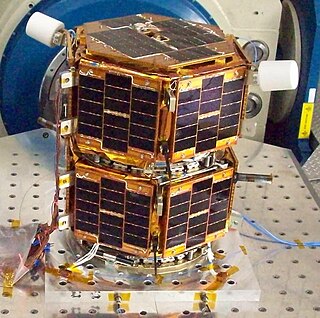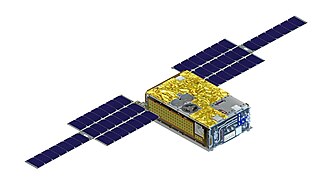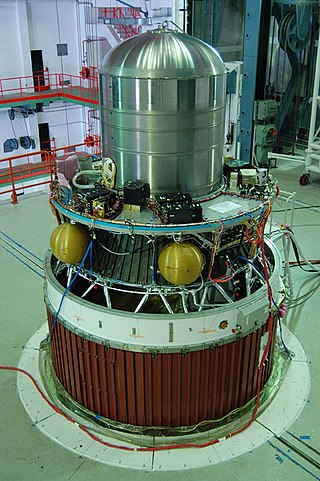Related Research Articles

An ion thruster, ion drive, or ion engine is a form of electric propulsion used for spacecraft propulsion. An ion thruster creates a cloud of positive ions from a neutral gas by ionizing it to extract some electrons from its atoms. The ions are then accelerated using electricity to create thrust. Ion thrusters are categorized as either electrostatic or electromagnetic.

A CubeSat is a class of small satellite with a form factor of 10 cm (3.9 in) cubes. CubeSats have a mass of no more than 2 kg (4.4 lb) per unit, and often use commercial off-the-shelf (COTS) components for their electronics and structure. CubeSats are deployed into orbit from the International Space Station, or launched as secondary payloads on a launch vehicle. As of December 2023, more than 2,300 CubeSats have been launched.

FalconSAT is the United States Air Force Academy's (USAFA) small satellite engineering program. Satellites are designed, built, tested, and operated by Academy cadets. The project is administered by the USAFA Space Systems Research Center under the direction of the Department of Astronautics. Most of the cadets who work on the project are pursuing a bachelor of science degree in astronautical engineering, although students from other disciplines join the project.
The United States Naval Academy (USNA) Small Satellite Program (SSP) was founded in 1999 to actively pursue flight opportunities for miniature satellites designed, constructed, tested, and commanded or controlled by Midshipmen. The Naval Academy's aerospace laboratory facilities are some of the most advanced and extensive in the country. These facilities include structures labs, propulsion and rotor labs, simulation labs, wind tunnels with flow velocities ranging from subsonic to supersonic, computer labs, and the Satellite Ground Station. The SSP provides funds for component purchase and construction, travel in support of testing and integration, coordination with The US Department of Defense or National Aeronautics and Space Administration (NASA) laboratories or with universities for collaborative projects, and guides Midshipmen through the Department of Defense (DoD) Space Experiments Review Board (SERB) flight selection process.

Formation Autonomy Spacecraft with Thrust, Relnav, Attitude and Crosslink is a pair of nanosatellites developed and built by students at The University of Texas at Austin. The project is part of a program sponsored by the Air Force Research Laboratory (AFRL), whose goal is to lead the development of affordable space technology. The FASTRAC mission will specifically investigate technologies that facilitate the operation of multiple satellites in formation. These enabling technologies include relative navigation, cross-link communications, attitude determination, and thrust. Due to the high cost of lifting mass into orbit, there is a strong initiative to miniaturize the overall weight of spacecraft. The utilization of formations of satellites, in place of large single satellites, reduces the risk of single point failure and allows for the use of low-cost hardware.
SSETI Express was the first spacecraft to be designed and built by European students and was launched by the European Space Agency. SSETI Express is a small spacecraft, similar in size and shape to a washing machine. On board the student-built spacecraft were three CubeSat picosatellites, extremely small satellites weighing around one kg each. These were deployed one hour and forty minutes after launch. Twenty-one university groups, working from locations spread across Europe and with very different cultural backgrounds, worked together via the internet to jointly create the satellite. The expected lifetime of the mission was planned to be 2 months. SSETI Express encountered an unusually fast mission development: less than 18 months from kick-off in January 2004 to flight-readiness.

Radio Aurora Explorer (RAX) is the first National Science Foundation sponsored CubeSat mission. The RAX mission is a joint effort between SRI International in Menlo Park, California and the University of Michigan in Ann Arbor, Michigan. The chief scientist at SRI International, Dr. Hasan Bahcivan, led his team at SRI to develop the payload while the chief engineer, Dr. James Cutler, led a team of students to develop the satellite bus in the Michigan Exploration Laboratory. There are currently two satellites in the RAX mission.
Technology Education Satellite (TechEdSat) is a successful nano-sat flight series conducted from the NASA Ames Research Center in collaboration with numerous universities. While one of the principal aims has been to introduce young professionals and university students to the practical realm of developing space flight hardware, considerable innovations have been introduced. In addition, this evolving flight platform has tested concepts for Low Earth Orbit (LEO) sample return, as well as planetary nano-sat class mission concepts.

The Nanoracks CubeSat Deployer (NRCSD) is a device to deploy CubeSats into orbit from the International Space Station (ISS).
ExoCube (CP-10) is a space weather satellite developed by the California Polytechnic State University – San Luis Obispo and sponsored by the National Science Foundation. It is one of many miniaturized satellites that adhere to the CubeSat standard. ExoCube's primary mission is to measure the density of hydrogen, oxygen, helium, and nitrogen in the Earth's exosphere. It is characterizing [O], [H], [He], [N2], [O+], [H+], [He+], [NO+], as well as the total ion density above ground stations, incoherent scatter radar (ISR) stations, and periodically throughout the entire orbit. It was launched aboard a Delta II rocket with the NASA SMAP primary payload from Vandenberg AFB in California on January 31, 2015.

Lunar Flashlight was a low-cost CubeSat lunar orbiter mission to explore, locate, and estimate size and composition of water ice deposits on the Moon for future exploitation by robots or humans.
LituanicaSAT-2 is a 3U Lithuanian CubeSat satellite launched on a Polar Satellite Launch Vehicle. This mission is led by Vilnius University in cooperation with NanoAvionics and is a part of the international "QB50" mission. LituanicaSAT-2 is an in-orbit technology demonstration mission during which the propulsion system prototype for small satellites will be tested. The satellite was deployed in Sun-synchronous orbit at an altitude of 475 km.
Team Miles was a 6U CubeSat that was to demonstrate navigation in deep space using innovative plasma thrusters. It was also to test a software-defined radio operating in the S-band for communications from about 4 million kilometers from Earth. Team Miles was one of ten CubeSats launched with the Artemis 1 mission into a heliocentric orbit in cislunar space on the maiden flight of the Space Launch System (SLS), that took place on 16 November 2022. Team Miles was deployed but contact was not established with the spacecraft.

EQUULEUS is a nanosatellite of the 6U CubeSat format that will measure the distribution of plasma that surrounds the Earth (plasmasphere) to help scientists understand the radiation environment in that region. It will also demonstrate low-thrust trajectory control techniques, such as multiple lunar flybys, within the Earth-Moon region using water steam as propellant. The spacecraft was designed and developed jointly by the Japan Aerospace Exploration Agency (JAXA) and the University of Tokyo.
CubeSail is a low-cost spacecraft propulsion demonstration mission using two identical 1.5U CubeSat satellites to deploy a 260 m (850 ft) long, 20 m2 (220 sq ft) solar sail ribbon between them. This mission is a first in a series of increasingly complex demonstrations leading up to a full-scale UltraSail heliogyro by the University of Illinois and CU Aerospace.
The Innovative Satellite Technology Demonstration Program is a series of spacecraft missions for testing technology and ideas put forward by universities and private companies. The program demonstrates various experimental devices and technology in space by providing flight opportunities. It is managed by the JAXA Research and Development Directorate. According to JAXA, the goal of this program is to test high risk, innovative technology that will lead to the space industry gaining competitiveness in the international field.

SpaceX CRS-27, also known as SpX-27, was a Commercial Resupply Service mission to the International Space Station (ISS) launched on 15 March 2023. The mission was contracted by NASA and was flown by SpaceX using Cargo Dragon C209. This was the seventh flight for SpaceX under NASA's CRS Phase 2.
RAISE-3 is a smallsat for technology demonstration developed by Mitsubishi Heavy Industries (MHI). Part of the Japanese space agency JAXA's Innovative Satellite Technology Demonstration Program, RAISE-3 carried multiple technologies that were selected for in-orbit demonstration. RAISE-3 was launched on 12 October 2022 by an Epsilon rocket as the main satellite of Innovative Satellite Technology Demonstration-3, but the launch resulted in a failure and the satellite was lost.

PSLV Orbital Experiment Platform (POEM) also known as PSLV Stage 4 Orbital Platform (PS4-OP) is an orbital micro-gravity test bed based on spent fourth stage of PSLV. By adding modular subsystems for power generation, communication and stabilization like photovoltaic cells, Telemetry and Telecommand (TT&C) package, attitude control system, data storage etc to the PSLV fourth stage, it can function as a satellite bus. This augmented stage can then host payloads for up to six months while in orbit, making it useful for qualifying components, gaining space heritage and conduct experiments in micro-gravity conditions. Usually the fourth stage of PSLV is discarded after deployment of satellite and remains in orbit for a significant duration in a passive state as a piece of space debris.
References
- ↑ ITSI Initiative (CubeSat @ UofI), retrieved 11 January 2014.
- ↑ Archived 2010-08-13 at the Wayback Machine IlliniSat-2, retrieved 11 January 2014.
- ↑ ION Information Sheet, retrieved 11 January 2014.
- ↑ Archived 2014-10-22 at the Wayback Machine NASA to launch two satellites developed by Illinois faculty, retrieved 17 October 2014